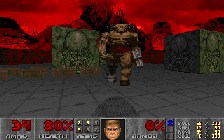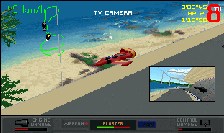SOFTWARE
3D ENGINES
At
the time of the 386, multimedia was a new-ish concept, especially for  the
PC which was by it's nature a business machine. The extra memory, storage
and of course processing power that came with the introduction of this
revolutionary processor, as well as the advent of the CD-ROM drive and
the growing popularity of the sound card allowed PC owners to do much more
than word processing and occasionally, play a game of Tetris. It also became
clear that the PC owning public wanted in-depth gaming experiences and
they wanted them to get better and better. The stage was set for the PC
to become the monster gaming and multimedia machine it is today.
the
PC which was by it's nature a business machine. The extra memory, storage
and of course processing power that came with the introduction of this
revolutionary processor, as well as the advent of the CD-ROM drive and
the growing popularity of the sound card allowed PC owners to do much more
than word processing and occasionally, play a game of Tetris. It also became
clear that the PC owning public wanted in-depth gaming experiences and
they wanted them to get better and better. The stage was set for the PC
to become the monster gaming and multimedia machine it is today.
Around
the same time, Commodore and other companies released their own multimedia
32-bit machines. The Amiga 1200 was the successor to the older 500 and
600's throne. It was based on the 68020 processor running at 14MHz. It
had a new video chipset called AGA which was capable of displaying 256,000
colours at once! This chipset far exceeded the capabilities of it's contemporaries
and the Amiga 1200 was, like it's predecessor, a success. Obviously, huge
leaps in power had been taken. Was it enough for the demands of 3D graphics?
The
answer, is, that in a limited way, yes. The 386 level computers did have
enough power to do a certain amount of 3D graphics processing, though not
necessarily polygon based 3D. On the PC you had examples like Doom, Geoff
Crammond's Grand Prix, numerous flight simulators and classics like Frontier
Elite 2. The Amiga 1200 and upward had games like Guardian, which was a
fast 3D shooter, not unlike StarFox on the SNES, albeit with better graphics
and sound. The Amiga never really advanced much beyond this point. Yes, there was the Amiga 4000 which was undoubtedly powerful, but, the
only software that really took advantage of that power was the likes of
Lightwave. Games remained at a decidely lower level and even the Amiga
CD32, Commodore's attempt at a games machine, although pretty good (I owned
one) didn't really catch on quickly enough due in part to the imminent arrival
of Sony's Playstation.
Yes, there was the Amiga 4000 which was undoubtedly powerful, but, the
only software that really took advantage of that power was the likes of
Lightwave. Games remained at a decidely lower level and even the Amiga
CD32, Commodore's attempt at a games machine, although pretty good (I owned
one) didn't really catch on quickly enough due in part to the imminent arrival
of Sony's Playstation.
None of the machines mentioned so far had 3D
capabilities as such. Instead,
the games programmers had to write what is known as a 3D engine. An engine
is the part of a program that controls or drives a certain task. Hence
you can get sound engines, AI engines and so on. The processor performs
all of the 3D calculations by following the directions of the software
engine, which, it had to execute in the first place. As you can imagine,
this takes a lot of processing power.
The
486 improved matters, making it possible to use polygons and textures a
bit more liberally than possible on a 386. Some of these games were quite
impressive. Striking examples are games like Little Big Adventure, Megarace,
EF2000, NASCAR Racing, Indy 500 and Wing Commander 3. Most of these games
came out towards the latter end of the 486's life. Just about this time,
the amazing PlayStation and Saturn arrived.

This
happened when the 486 was at the 66 to 100MHz stage and the Pentium had
only just been launched in a 60Mhz flavour. Not even the mighty, new Pentium
processor could copy the speed of these two new consoles. What was it that
made these relatively cheap machines so powerful?
Continue
 the
PC which was by it's nature a business machine. The extra memory, storage
and of course processing power that came with the introduction of this
revolutionary processor, as well as the advent of the CD-ROM drive and
the growing popularity of the sound card allowed PC owners to do much more
than word processing and occasionally, play a game of Tetris. It also became
clear that the PC owning public wanted in-depth gaming experiences and
they wanted them to get better and better. The stage was set for the PC
to become the monster gaming and multimedia machine it is today.
the
PC which was by it's nature a business machine. The extra memory, storage
and of course processing power that came with the introduction of this
revolutionary processor, as well as the advent of the CD-ROM drive and
the growing popularity of the sound card allowed PC owners to do much more
than word processing and occasionally, play a game of Tetris. It also became
clear that the PC owning public wanted in-depth gaming experiences and
they wanted them to get better and better. The stage was set for the PC
to become the monster gaming and multimedia machine it is today.
 Yes, there was the Amiga 4000 which was undoubtedly powerful, but, the
only software that really took advantage of that power was the likes of
Lightwave. Games remained at a decidely lower level and even the Amiga
CD32, Commodore's attempt at a games machine, although pretty good (I owned
one) didn't really catch on quickly enough due in part to the imminent arrival
of Sony's Playstation.
Yes, there was the Amiga 4000 which was undoubtedly powerful, but, the
only software that really took advantage of that power was the likes of
Lightwave. Games remained at a decidely lower level and even the Amiga
CD32, Commodore's attempt at a games machine, although pretty good (I owned
one) didn't really catch on quickly enough due in part to the imminent arrival
of Sony's Playstation.
